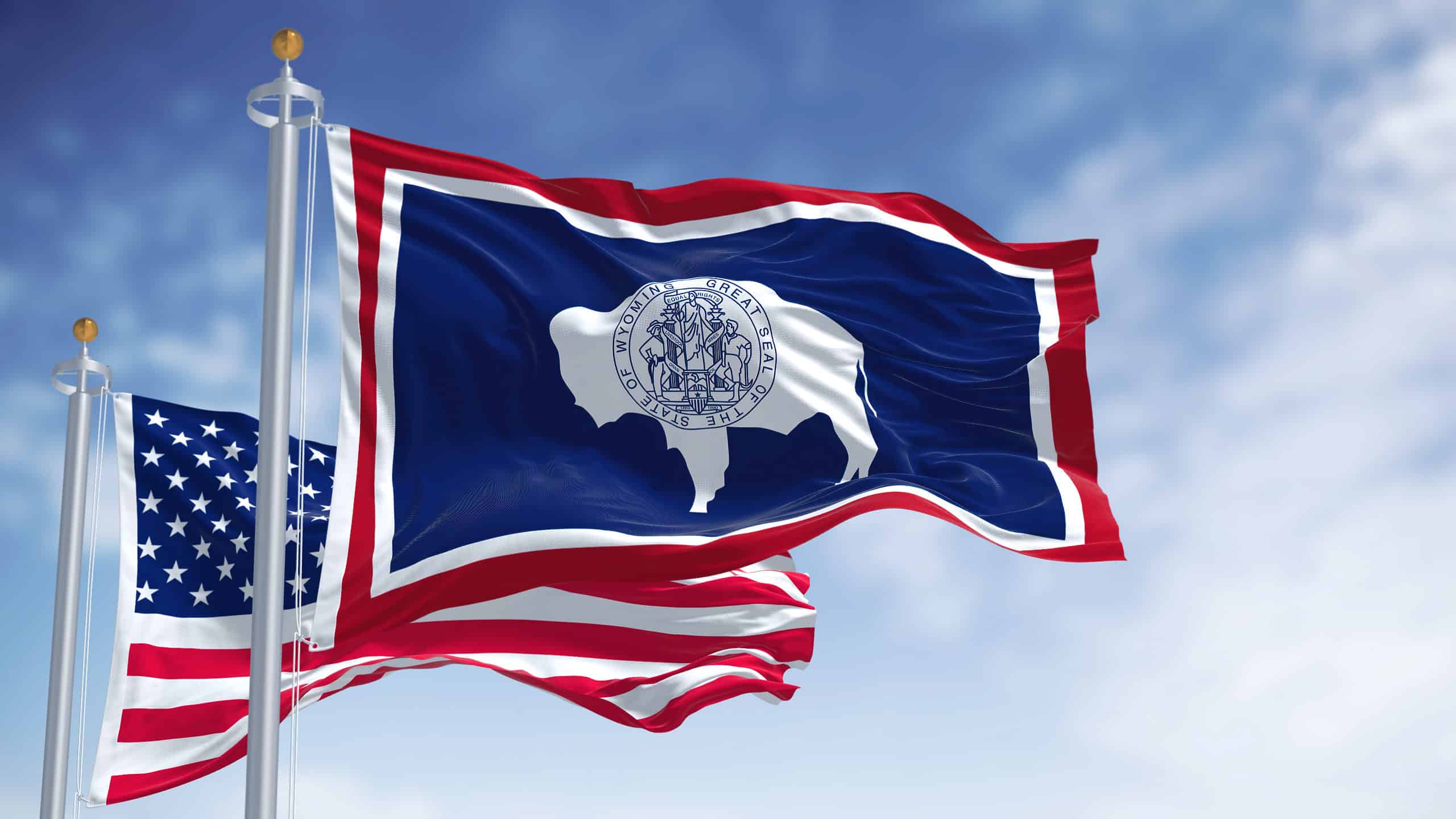Wyoming is one of the last true frontiers in the United States. Rolling plains, soaring mountains, crystal-clear lakes, and iconic western wildlife draw hundreds of thousands of tourists every year. The crown jewel of the state is Yellowstone National Park, with its otherworldly geysers and other geothermal features. Even though you might want to go there to get away from the city, it would be a mistake to overlook Wyoming’s own historic cities. This article will describe five of the state’s oldest cities to give you a taste of their history and present-day attractions for visitors of all ages and interests.

Why Are Wyoming’s Oldest Cities in the South?
You’ll notice that the oldest cities in Wyoming are all strung across the southern part of the state. This is because they were built in association with the transcontinental railroad. With the improvement of transportation, more people could move to the state and get the supplies they needed, forming more settlements further north.
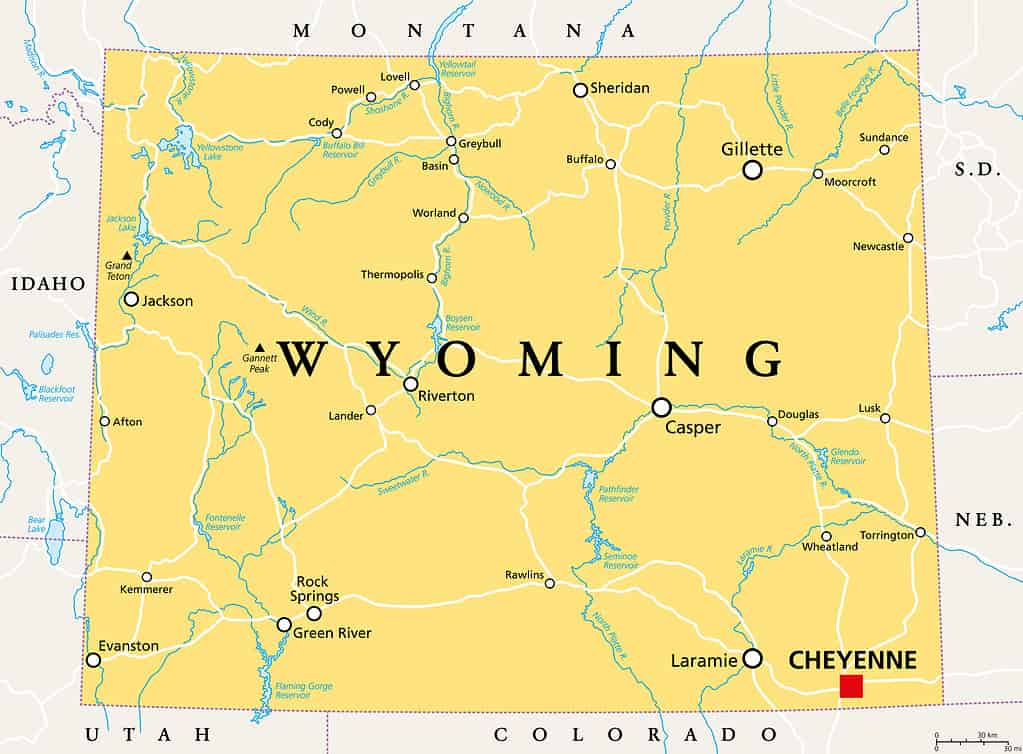
Wyoming and Colorado are the only two states with an unbroken rectangular shape.
©PeterHermesFurian/iStock via Getty Images
1. Cheyenne (1867)
Cheyenne is the capital and largest city in Wyoming, even though its population is only 65,132 people. It is located on Crow Creek at the southeastern corner of the state near Nebraska. The Union Pacific Railroad platted the city and named it in honor of the local Native American tribe indigenous to the area. The city prospered from ranching and as a supply point for prospectors headed to the Black Hills gold rush. The U.S. Army built Fort D.A. Russell there to protect railroad crews. It was home to three black regiments, including the famous Buffalo Soldiers. The base later was converted into the Francis E. Warren Air Force Base, which became an important nuclear facility during the Cold War.
Here are some of the interesting things you can see and do in Cheyenne:
- Cheyenne Frontier Days – This is Wyoming’s most popular annual event, which has been going on since 1897. It includes an enormous rodeo, carnival, and parade, music, food, and vendors. There is also a nearby Old Frontier Town and Indian Village for visitors to tour.
- Cheyenne Depot Museum – A Union Pacific Railroad depot that now is a museum focused on the railroad and the cowboy culture of the Old West.
- Wyoming State Museum – This museum is located next to the State Capitol building. It has exhibits on the natural history of the state, Native American culture, pioneer settlements, mining, ranching, and national parks.
- Terry Bison Ranch – A ranch on the Wyoming-Colorado border with over 2,500 head of bison. Visitors can hand-feed bison, participate in cattle drives, ride horses or ATVs, and fish.

A spectacular sunset over Cheyenne, Wyoming.
©Jacob Boomsma/Shutterstock.com
2. Laramie (1868)
Located just 49 miles west of Cheyenne, Laramie has a current population of 31,407. It is situated in a valley between the Laramie Mountains to the east and the Snowy Range to the west. The Union Pacific Railroad established the town and named it after the Laramie River, which had been named for a French trapper who explored the region. The town was originally so lawless that local vigilantes took matters into their own hands, lynching criminals and running others out of town. Butch Cassidy was incarcerated in the Wyoming Territorial Prison there for two years.
Visitors to Laramie should consider checking out these attractions:
- Jubilee Days – This annual July festival celebrates Wyoming statehood. You’ll find food, games, live music, a parade, rodeo events, a street fair, and carnival rides.
- Medicine Bow-Routt National Forests – This wild area runs from central Wyoming to central Colorado. It includes parts of several mountain ranges, including the Gore Range, Medicine Bow Mountains, Laramie Range, and the Sierra Madre.
- University of Wyoming Geological Museum – Wyoming is a prime location for fossil hunters. This museum is one of the best places to see some of the spectacular finds, including your favorite dinosaurs such as the T-Rex, brontosaurus, and triceratops.
- Racing events are popular in Laramie, including mountain biking, skiing, running, and traditional bike racing.

Historic military housing at the Fort Laramie National Historic Site.
©iStock.com/rozdemir01
3. Rawlins (1868)
Rawlins is a city of 8,221 people located about 100 miles west of Laramie north of the Colorado border. it was a supply depot and railway station for the Union Pacific Railroad. It was named after General John Rawlins, chief-of-staff for General U.S. Grant, who helped survey the route for the railroad. One of the unusual commodities of Rawlins was paint made from hematite deposits that were used to make durable, rust-resistant red paint. This paint was used in major landmarks across the country, including the Brooklyn Bridge. Rawlins also prospered as a transportation hub for cattle bound for markets in Denver or Omaha.
Here are some things you will want to include on your itinerary when visiting Rawlins:
- Carbon County Museum – A museum of regional history, including the natural environment and Native American culture and history.
- Carbon County Fair and Rodeo – This event includes all the rodeo and street fair events you can imagine, as well as a demolition derby.
- Rocking Horse Ranch Resort – This resort has heated pools, waterslides, and an indoor water park, as well as hotel, restaurant, and entertainment facilities.
- Wyoming Frontier Prison – For those interested in the darker side of history, this prison has stories to tell. Visitors will learn about the inhumane conditions and punishments that took place here before prison reforms.
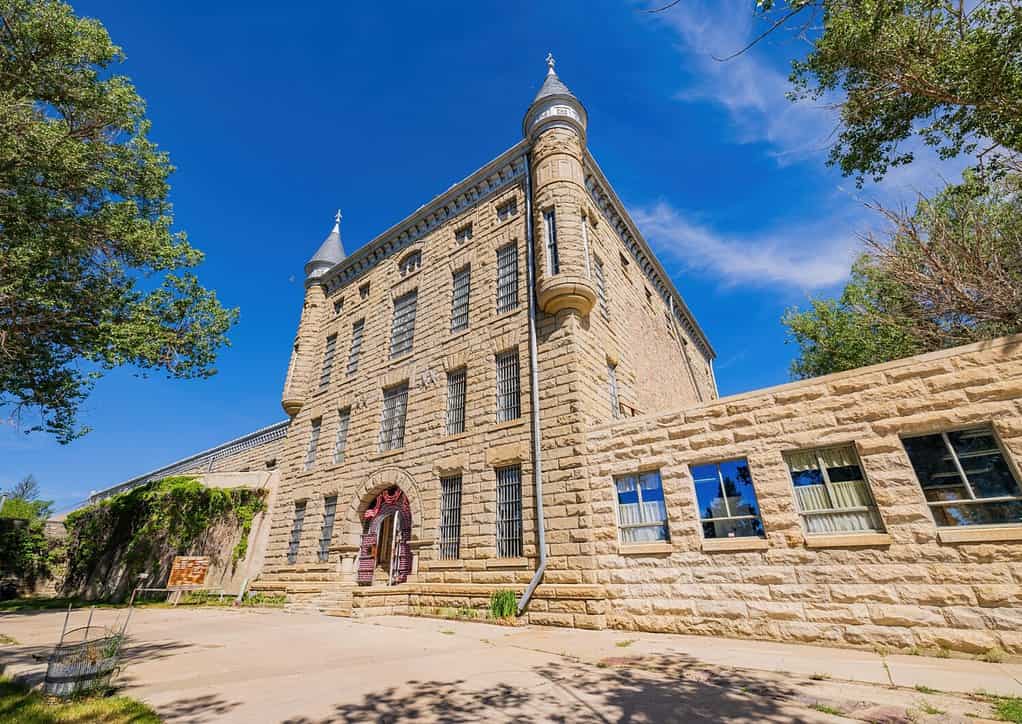
The Wyoming Frontier Prison Museum explores the darker side of the state’s lawless history.
©Kit Leong/Shutterstock.com
4. Green River (1868)
Green River (population 11,825) is located 122 miles West of Rawlins, northwest of where the borders of Colorado and Utah meet. It was named for the Green River, which was originally called the Spanish River but was renamed for its green soapstone banks. The area has petroleum and soda ash resources that are important in manufacturing. In the regional economy, Green River is a center for forest, livestock, and farm products.
Green River is a small community but it has some interesting tourist attractions:
- Pilot Butte Wildhorse Scenic Loop – Tourists with high-clearance vehicles can drive the rough gravel roads of this loop to see wild horses of Spanish and American heritage and other wildlife.
- Seedskadee National Wildlife Refuge – A prairie and river habitat with an abundance of indigenous wildlife. Visitors can take a driving tour along the river, paddle in boats, or walk a network of trails.
- Killpecker Sand Dunes – This is a protected wildlife habitat with some areas open for recreation. The dunes are popular for off-road vehicles, hiking, and horseback riding.
- Flaming Gorge Days – A festival with races, games, and music performances by well-known artists.
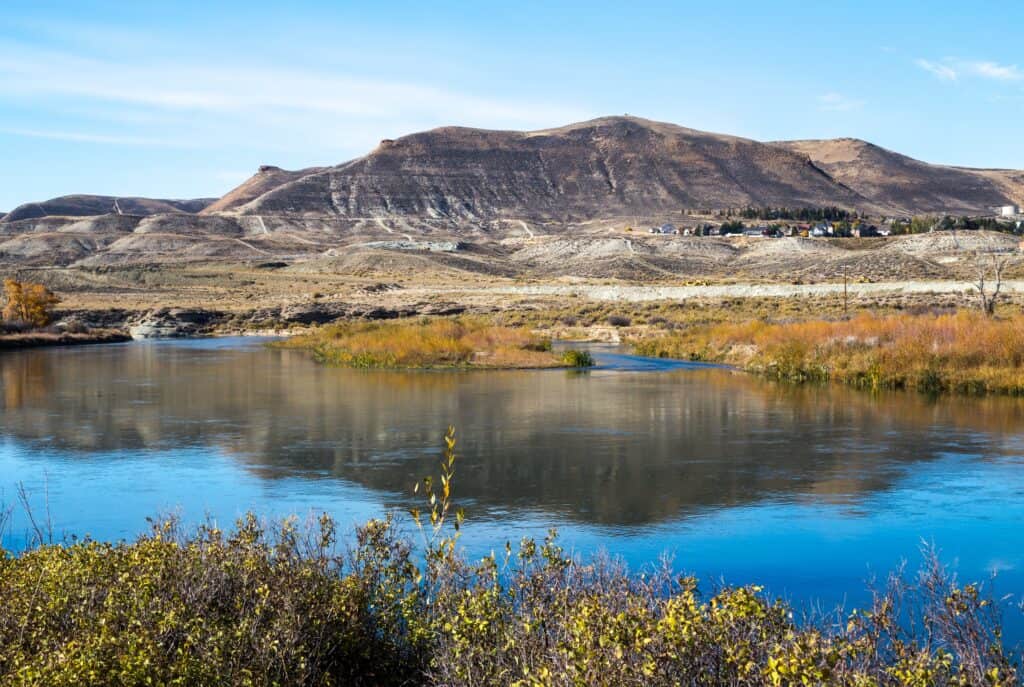
The Green River in Wyoming has beautiful rock formations that make for scenic views.
©Victoria Ditkovsky/Shutterstock.com
5. Evanston (1868)
With a population of 11,747, Evanston is located in the southwestern corner of the state, bordered by Utah on the South and West. The temperature there is mile most of the year, rarely dropping below below 0°F or going above 89°F. Like the other major cities across southern Wyoming, Evanston was founded during the construction of the transcontinental railroad. With coal, timber, and water abundant in the area, it became a refueling station for locomotives. Many of the historic buildings have been restored now.
What can you do in Evanston? Check out these possibilities:
- Bear River State Park – A park with paved and dirt trails for hiking, snowshoeing, and cross-country skiing. You’ll see small herds of bison and elk in the park. You can also kayak, float, and fish on Bear River or walk along the riverwalk.
- Joss House – A replica of a Chinese Joss House (temple) is located on Depot Square. You’ll see a scale model of the city’s original Chinatown, that housed railroad workers.
- Fort Bridger State Park – Fort Bridger was a fur trading post that became a supply stop for wagon trains traveling the Oregon and California trails and also served as a Pony Express station. Some of its historic structures have been restored. You can take guided tours and see living history demonstrations.

The landscape around Evanston has its own unique beauty in every season of the year.
©Anna Westman/Shutterstock.com
What About Yellowstone?
But what about Yellowstone National Park? Which of these cities is closest if you’re driving? The best route all depends on which direction you’re driving from and which entrance to the Park you choose to take. The Park is located in the far northwestern corner. Evanston is in the far southeast. However, there is no one interstate or direct route to the north from there to the Park; you’ll have to use a series of smaller highways. Visitors driving from the East or Southeast may choose to go through Cheyenne to Caspar all the way north to Sheridan, then West to Yellowstone. Others may choose to go through Cheyenne to Laramie and Rawlins before heading northwest. So on your next vacation, consider including some of these cities on an unforgettable drive across wild Wyoming.
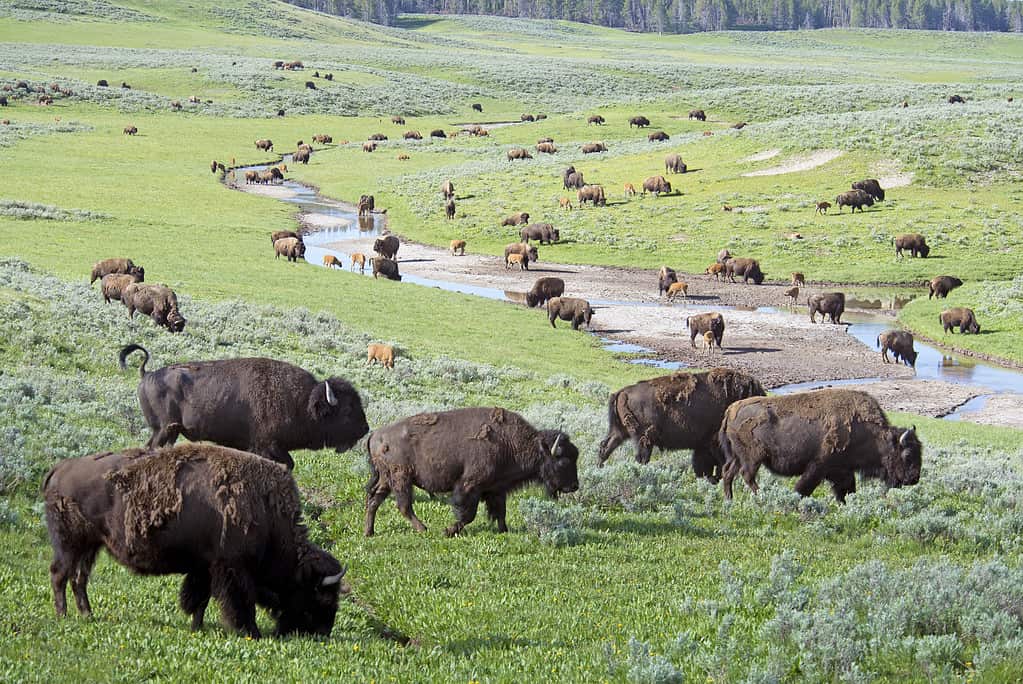
Bison herd in Yellowstone National Park.
©iStock.com/Betty4240
Summary of the 5 Oldest Cities in Wyoming
| City | Age | |
|---|---|---|
| 1 | Cheyenne | 1867 |
| 2 | Laramie | 1868 |
| 3 | Rawlins | 1868 |
| 4 | Green River | 1868 |
| 5 | Evanston | 1868 |
Thank you for reading! Have some feedback for us? Contact the AZ Animals editorial team.

